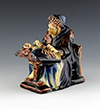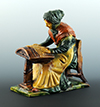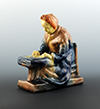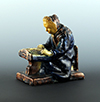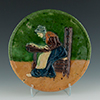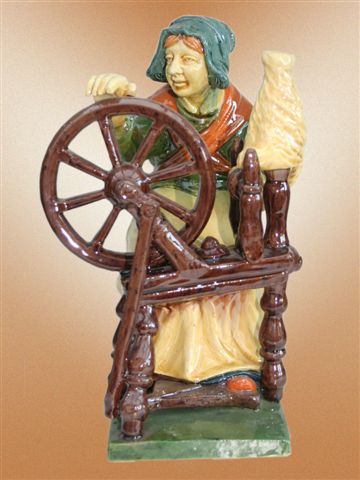Flemish Pottery Lacemakers
|
References to Flemish Pottery (information is more commonly found under "Vlaams Aardewerk" in Flemish, or "Poterie Flamande" in French) date back over a thousand years. Brugge was a major center of export. The pottery is a lead-glaze earthenware and is used for household items as well as decorative figures. Note, the lead-glaze is toxic if ingested, but an acceptable substitute that preserves the brilliant colors has not been found. A history of this art (in Flemish) can be found at http://www.vlaams-aardewerk-gjm.be/index.html. Vlaams Aardewerk includes vases, jars, candlesticks, wall pieces, and other traditional forms, as well as many different figures, primarily local crafts people and religious images. The lacemaker is not the only textile-related figure; flax spinning was also modelled. The one shown below (not in my collection) has a saxony type wheel. A spinster at an upright wheel can also be found, and I have also seen a woman winding yarn from a swift. Occasionally the Lacemaker and a Spinner will be made as a pair.
Flemish pottery is primarily made in Vlaanderen, the northern part of Belgium in small potteries, often family businesses. The earliest lacemakers were made around 1900, and I don't know if it is possible to find them earlier. The figures come in many different variations, including raised images on plates. Brugges is known for the 'Flame method', in which colors are painted onto the slip, and form 'flames' as they run during firing. Among the better makers each piece was individually crafted, resulting in slight variations in similar pieces. Look for differences in the detail of the drapery, and in the placement of the feet around the base of the pillow stand. The best pieces have brilliant colors, good modelling around the hands and bobbins, naturally flowing drapery, and openwork in a well modelled stand and chair. Occasionally one can find a dog or cat under the chair. Many of these figures are not signed, but a few artists can be identified by marks or by general style (how the rutching on the hat is handled is an excellent marker). Modern copies are being made, but it is difficult to attribute date without a known provenance, and frankly, quality is usually high throughout the 20th century. I am trying to contact Belgian collectors to see what they know about unsigned pieces. I have grouped the thumbnails above either by known maker or similarity of style. Plaster copies were also made, see for example Plaster Figure. Note that these lacemaker figures always place pins with the right hand; therefore I've made the thumbnail for each piece with the right hand at the back. This figure is very poorly documented in English. Some examples can be seen in a set of postcards for sale at the Kantcentrum in Brugges: Kantcentrum Postcards. The pottery is very delicate, and the figures are often chipped at the edges, or broken and repaired. The yellow flesh and orange hair takes some getting used to, but overall these figures are absolutely delightful. First posted 1/23/2009 |





